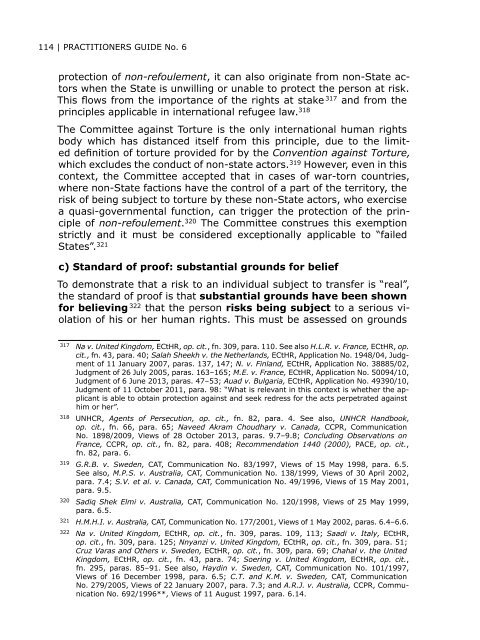Universal-MigrationHRlaw-PG-no-6-Publications-PractitionersGuide-2014-eng
Universal-MigrationHRlaw-PG-no-6-Publications-PractitionersGuide-2014-eng
Universal-MigrationHRlaw-PG-no-6-Publications-PractitionersGuide-2014-eng
Create successful ePaper yourself
Turn your PDF publications into a flip-book with our unique Google optimized e-Paper software.
114 | PRACTITIONERS GUIDE No. 6<br />
protection of <strong>no</strong>n-refoulement, it can also originate from <strong>no</strong>n-State actors<br />
when the State is unwilling or unable to protect the person at risk.<br />
This flows from the importance of the rights at stake 317 and from the<br />
principles applicable in international refugee law. 318<br />
The Committee against Torture is the only international human rights<br />
body which has distanced itself from this principle, due to the limited<br />
definition of torture provided for by the Convention against Torture,<br />
which excludes the conduct of <strong>no</strong>n-state actors. 319 However, even in this<br />
context, the Committee accepted that in cases of war-torn countries,<br />
where <strong>no</strong>n-State factions have the control of a part of the territory, the<br />
risk of being subject to torture by these <strong>no</strong>n-State actors, who exercise<br />
a quasi-governmental function, can trigger the protection of the principle<br />
of <strong>no</strong>n-refoulement. 320 The Committee construes this exemption<br />
strictly and it must be considered exceptionally applicable to “failed<br />
States”. 321<br />
c) Standard of proof: substantial grounds for belief<br />
To demonstrate that a risk to an individual subject to transfer is “real”,<br />
the standard of proof is that substantial grounds have been shown<br />
for believing 322 that the person risks being subject to a serious violation<br />
of his or her human rights. This must be assessed on grounds<br />
317 Na v. United Kingdom, ECtHR, op. cit., fn. 309, para. 110. See also H.L.R. v. France, ECtHR, op.<br />
cit., fn. 43, para. 40; Salah Sheekh v. the Netherlands, ECtHR, Application No. 1948/04, Judgment<br />
of 11 January 2007, paras. 137, 147; N. v. Finland, ECtHR, Application No. 38885/02,<br />
Judgment of 26 July 2005, paras. 163–165; M.E. v. France, ECtHR, Application No. 50094/10,<br />
Judgment of 6 June 2013, paras. 47–53; Auad v. Bulgaria, ECtHR, Application No. 49390/10,<br />
Judgment of 11 October 2011, para. 98: “What is relevant in this context is whether the applicant<br />
is able to obtain protection against and seek redress for the acts perpetrated against<br />
him or her”.<br />
318 UNHCR, Agents of Persecution, op. cit., fn. 82, para. 4. See also, UNHCR Handbook,<br />
op. cit., fn. 66, para. 65; Naveed Akram Choudhary v. Canada, CCPR, Communication<br />
No. 1898/2009, Views of 28 October 2013, paras. 9.7–9.8; Concluding Observations on<br />
France, CCPR, op. cit., fn. 82, para. 408; Recommendation 1440 (2000), PACE, op. cit.,<br />
fn. 82, para. 6.<br />
319 G.R.B. v. Sweden, CAT, Communication No. 83/1997, Views of 15 May 1998, para. 6.5.<br />
See also, M.P.S. v. Australia, CAT, Communication No. 138/1999, Views of 30 April 2002,<br />
para. 7.4; S.V. et al. v. Canada, CAT, Communication No. 49/1996, Views of 15 May 2001,<br />
para. 9.5.<br />
320 Sadiq Shek Elmi v. Australia, CAT, Communication No. 120/1998, Views of 25 May 1999,<br />
para. 6.5.<br />
321 H.M.H.I. v. Australia, CAT, Communication No. 177/2001, Views of 1 May 2002, paras. 6.4–6.6.<br />
322 Na v. United Kingdom, ECtHR, op. cit., fn. 309, paras. 109, 113; Saadi v. Italy, ECtHR,<br />
op. cit., fn. 309, para. 125; Nnyanzi v. United Kingdom, ECtHR, op. cit., fn. 309, para. 51;<br />
Cruz Varas and Others v. Sweden, ECtHR, op. cit., fn. 309, para. 69; Chahal v. the United<br />
Kingdom, ECtHR, op. cit., fn. 43, para. 74; Soering v. United Kingdom, ECtHR, op. cit.,<br />
fn. 295, paras. 85–91. See also, Haydin v. Sweden, CAT, Communication No. 101/1997,<br />
Views of 16 December 1998, para. 6.5; C.T. and K.M. v. Sweden, CAT, Communication<br />
No. 279/2005, Views of 22 January 2007, para. 7.3; and A.R.J. v. Australia, CCPR, Communication<br />
No. 692/1996**, Views of 11 August 1997, para. 6.14.



